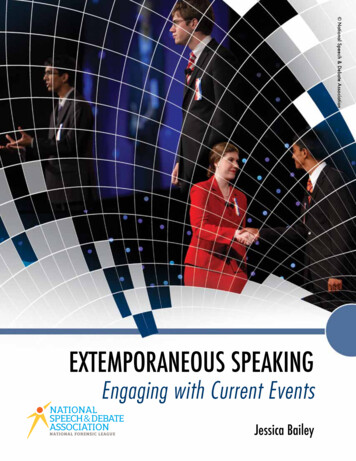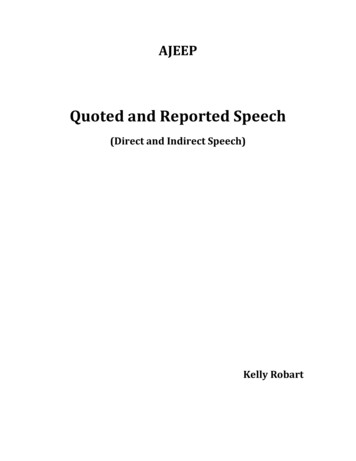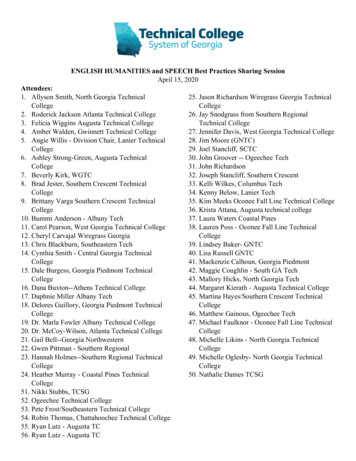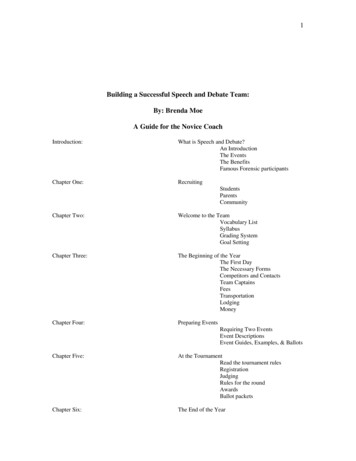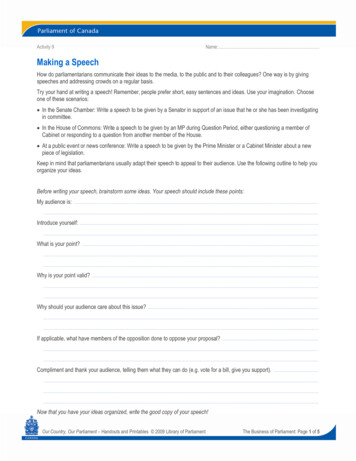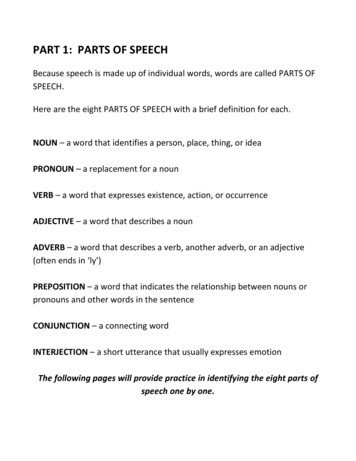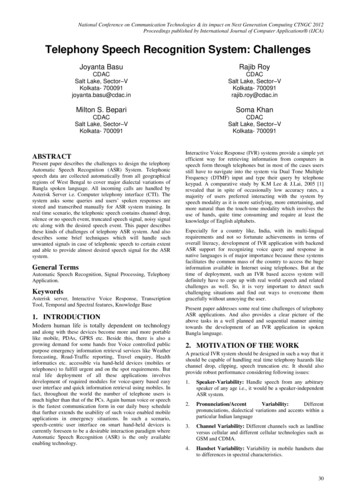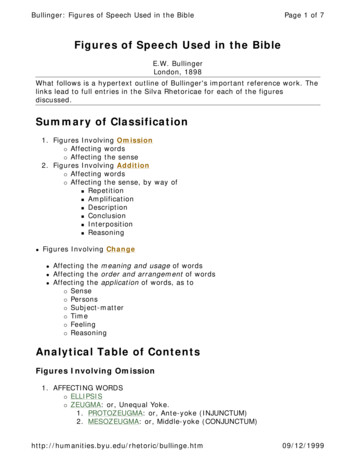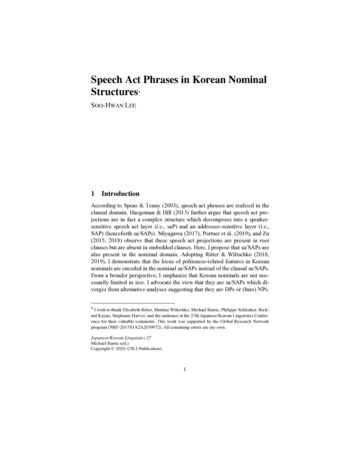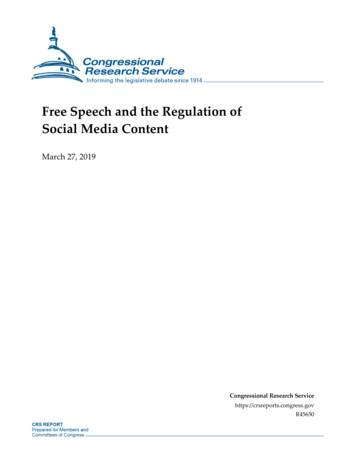
Transcription
Free Speech and the Regulation ofSocial Media ContentMarch 27, 2019Congressional Research Servicehttps://crsreports.congress.govR45650
SUMMARYFree Speech and the Regulation ofSocial Media ContentAs the Supreme Court has recognized, social media sites like Facebook and Twitter have becomeimportant venues for users to exercise free speech rights protected under the First Amendment.Commentators and legislators, however, have questioned whether these social media platformsare living up to their reputation as digital public forums. Some have expressed concern that thesesites are not doing enough to counter violent or false speech. At the same time, many argue thatthe platforms are unfairly banning and restricting access to potentially valuable speech.R45650March 27, 2019Valerie C. BrannonLegislative AttorneyCurrently, federal law does not offer much recourse for social media users who seek to challenge a social media provider’sdecision about whether and how to present a user’s content. Lawsuits predicated on these sites’ decisions to host or removecontent have been largely unsuccessful, facing at least two significant barriers under existing federal law. First, whileindividuals have sometimes alleged that these companies violated their free speech rights by discriminating against users’content, courts have held that the First Amendment, which provides protection against state action, is not implicated by theactions of these private companies. Second, courts have concluded that many non-constitutional claims are barred by Section230 of the Communications Decency Act, 47 U.S.C. § 230, which provides immunity to providers of interactive computerservices, including social media providers, both for certain decisions to host content created by others and for actions taken“voluntarily” and “in good faith” to restrict access to “objectionable” material.Some have argued that Congress should step in to regulate social media sites. Government action regulating internet contentwould constitute state action that may implicate the First Amendment. In particular, social media providers may argue thatgovernment regulations impermissibly infringe on the providers’ own constitutional free speech rights. Legal commentatorshave argued that when social media platforms decide whether and how to post users’ content, these publication decisions arethemselves protected under the First Amendment. There are few court decisions evaluating whether a social media site, byvirtue of publishing, organizing, or even editing protected speech, is itself exercising free speech rights. Consequently,commentators have largely analyzed the question of whether the First Amendment protects a social media site’s publicationdecisions by analogy to other types of First Amendment cases. There are at least three possible frameworks for analyzinggovernmental restrictions on social media sites’ ability to moderate user content.First, using the analogue of the company town, social media sites could be treated as state actors who are themselves boundto follow the First Amendment when they regulate protected speech. If social media sites were treated as state actors underthe First Amendment, then the Constitution itself would constrain their conduct, even absent legislative regulation. Thesecond possible framework would view social media sites as analogous to special industries like common carriers orbroadcast media. The Court has historically allowed greater regulation of these industries’ speech, given the need to protectpublic access for users of their services. Under the second framework, if special aspects of social media sites threaten the useof the medium for communicative or expressive purposes, courts might approve of content-neutral regulations intended tosolve those problems. The third analogy would treat social media sites like news editors, who generally receive the fullprotections of the First Amendment when making editorial decisions. If social media sites were considered to be equivalentto newspaper editors when they make decisions about whether and how to present users’ content, then those editorialdecisions would receive the broadest protections under the First Amendment. Any government regulations that alter theeditorial choices of social media sites by forcing them to host content that they would not otherwise transmit, or requiringthem to take down content they would like to host, could be subject to strict scrutiny. A number of federal trial courts haveheld that search engines exercise editorial judgment protected by the First Amendment when they make decisions aboutwhether and how to present specific websites or advertisements in search results, seemingly adopting this last framework.Which of these three frameworks applies will depend largely on the particular action being regulated. Under existing law,social media platforms may be more likely to receive First Amendment protection when they exercise more editorialdiscretion in presenting user-generated content, rather than if they neutrally transmit all such content. In addition, certaintypes of speech receive less protection under the First Amendment. Courts may be more likely to uphold regulations targetingcertain disfavored categories of speech such as obscenity or speech inciting violence. Finally, if a law targets a social mediasite’s conduct rather than speech, it may not trigger the protections of the First Amendment at all.Congressional Research Service
Free Speech and the Regulation of Social Media ContentContentsExisting Legal Barriers to Private Lawsuits Against Social Media Providers . 4First Amendment: State Action Requirement. 5Section 230 of the CDA . 9Section 230(c)(1) .11Section 230(c)(2) . 13First Amendment Limits on Government Regulation of Social Media Content . 15Background Principles: First Amendment Protections Online. 17Social Media Sites: Providing a Digital Public Square . 21Social Media Sites as Company Towns . 23Social Media Sites as Broadcasters or Cable Providers . 27Social Media Sites as Editors . 33Considerations for Congress. 40ContactsAuthor Information. 43Congressional Research Service
Free Speech and the Regulation of Social Media Contentne of the core purposes of the First Amendment’s Free Speech Clause is to foster “anuninhibited marketplace of ideas,”1 testing the “truth” of various ideas “in thecompetition of the market.”2 Social media sites3 provide one avenue for thetransmission of those ideas.4 The Supreme Court has recognized that the internet ingeneral, and social media sites in particular, are “important places” for people to“speak and listen,” observing that “social media users employ these websites to engage in a widearray of protected First Amendment activity.”5 Users of social media sites such as Facebook,Twitter, YouTube, or Instagram can use these platforms to post art or news,6 debate politicalissues,7 and document their lives.8 In a study conducted in early 2018, the Pew Research Centerfound that 68% of U.S. adults use Facebook, 35% use Instagram, and 24% report using Twitter.9These sites not only allow users to post content, they also connect users with each other, allowingusers to seek out friends and content and often recommending new connections to the user.10 Onmost social media platforms, users can then send content to specific people, or set permissionsallowing only certain people to view that content. Through human curation and the use ofalgorithms, these platforms decide how content is displayed to other users.11 In curating thiscontent, social media sites may also edit user content, combine it, or draft their own additions tothat content.12 These platforms are generally free to users, and make revenue by selling targetedO1Virginia v. Hicks, 539 U.S. 113, 119 (2003).Abrams v. United States, 250 U.S. 616, 630 (1919) (Holmes, J., dissenting). Accord, e.g., Red Lion Broad. Co. v.FCC, 395 U.S. 367, 390 (1969).3 The report does not precisely define the term “social media site,” given that most of the cases defining FirstAmendment rights on the internet focus more on various companies’ actions than their character. For one possibletaxonomy of internet “intermediaries” proposed for future First Amendment analysis, see David S. Ardia, Free SpeechSavior or Shield for Scoundrels: An Empirical Study of Intermediary Immunity under Section 230 of theCommunications Decency Act, 43 LOY. L.A. L. REV. 373, 386–87 (2010).4 See, e.g., Nicholas A. Primrose, Has Society Become Tolerant of Further Infringement on First Amendment Rights?,19 BARRY L. REV. 313, 333 (2014) (“Social media is the ideal ‘marketplace’ for the 21st century; it creates a dynamicplace for every conceivable opinion to be expressed and shared.”).5 Packingham v. North Carolina, 137 S. Ct. 1730, 1735–36 (2017).6 See, e.g., Elisa Shearer, Social Media Outpaces Print Newspapers in the U.S. as a News Source, PEW RESEARCH CTR.FACT TANK (Dec. 10, 2018), https://pewrsr.ch/2UvWPSe.7 See, e.g., Kristen Bialik, 14% of Americans Have Changed their Mind about an Issue Because of Something They Sawon Social Media, PEW RESEARCH CTR. FACT TANK (Aug. 15, 2018), https://pewrsr.ch/2Bc5TWF.8 See, e.g., Aaron Smith & Monica Anderson, Social Media Use in 2018, PEW RESEARCH CTR. FACT TANK (Mar. 1,2018), https://pewrsr.ch/2FDfiFd.9 Id.10 While many social media platforms are primarily centered around connections with friends or followers, this is notuniversally true. For example, commentators have discussed the app TikTok as an alternative to this friend-centricapproach, noting that the platform opens to a page full of content that an algorithm has determined may interest the userbased on past usage habits, rather than to a feed of friends’ content. See, e.g., Caroline Haskins, TikTok Can’t Save Usfrom Algorithmic Content Hell, VICE MOTHERBOARD (Jan. 31, 2019), https://bit.ly/2Jlu1dF; John Herrman, How TikTokIs Rewriting the World, N.Y. TIMES (Mar. 10, 2019), https://nyti.ms/2Hm0ygS.11 See, e.g., Paul Hitlin & Lee Rainie, Facebook Algorithms and Personal Data, PEW RESEARCH CTR. (Jan. 16, 2019),https://pewrsr.ch/2Hnqr1o; Will Oremus, Twitter’s New Order, SLATE (Mar. 5, 2017), https://bit.ly/2lMs0pU.12 For example, Twitter sometimes creates “Moments,” which it describes as “curated stories showcasing the very bestof what’s happening on Twitter.” About Moments, TWITTER, https://bit.ly/2x0AxOt (last visited Mar. 27, 2019).2Congressional Research Service1
Free Speech and the Regulation of Social Media Contentadvertising space,13 among other things.14 Thus, social media sites engage in a wide variety ofactivities, at least some of which entail hosting—and creating—constitutionally protected speech.Social media companies have recognized their role in providing platforms for speech.15 To takeone example, in a September 2018 hearing before the Senate Select Committee on Intelligence,the founder and Chief Executive Officer of Twitter, Jack Dorsey, repeatedly referred to Twitter asa “digital public square,” emphasizing the importance of “free and open exchange” on theplatform.16 Critically, however, social media sites also have content-moderation policies underwhich they may remove certain content. Further, these sites determine how content is presented:who sees it, when, and where. As one scholar has said, social media sites “create rules andsystems to curate speech out of a sense of corporate social responsibility, but also . . . becausetheir economic viability depends on meeting users’ speech and community norms.”17 Speechposted on the internet “exists in an architecture of privately owned websites, servers, routers, andbackbones,” and its existence online is subject to the rules of those private companies.18Consequently, one First Amendment scholar predicted ten years ago that “the most importantdecisions affecting the future of freedom of speech will not occur in constitutional law; they willbe decisions about technological design, legislative and administrative regulations, the formationof new business models, and the collective activities of end-users.”19Social media companies have come under increased scrutiny regarding the type of user contentthat they allow to be posted on their sites, and the ways in which they may promote—ordeemphasize—certain content. A wide variety of people have expressed concern that these sitesdo not do enough to counter harmful, offensive, or false content.20 At the same time, others haveSee, e.g., Kalev Leetaru, What Does It Mean For Social Media Platforms To “Sell” Our Data?, FORBES (Dec. 15,2018), https://bit.ly/2W5MfRL; Louise Matsakis, Facebook’s Targeted Ads Are More Complex Than It Lets On,WIRED (Apr. 25, 2018, 4:04 PM), https://bit.ly/2DZ1CG0.14 Some otherwise free sites include a subscription option, allowing certain users to pay fees to access premium contentor unlock certain features. See, e.g., LinkedIn Free Accounts and Premium Subscriptions, LINKEDIN, https://bit.ly/2sRWDhR (last visite
27.03.2019 · Free Speech and the Regulation of Social Media Content As the Supreme Court has recognized, social media sites like Facebook and Twitter have become important venues for users to exercise free speech rights protected under the First Amendment. Commentators and legislators, however, have questioned whether these social media platforms
